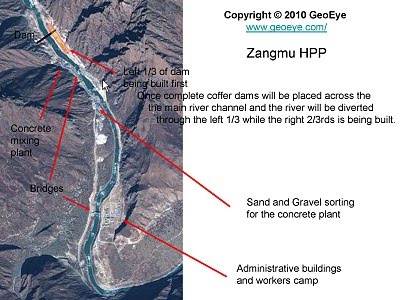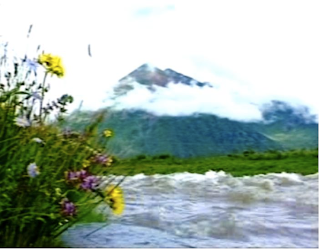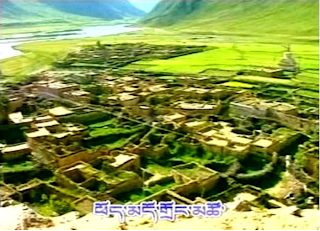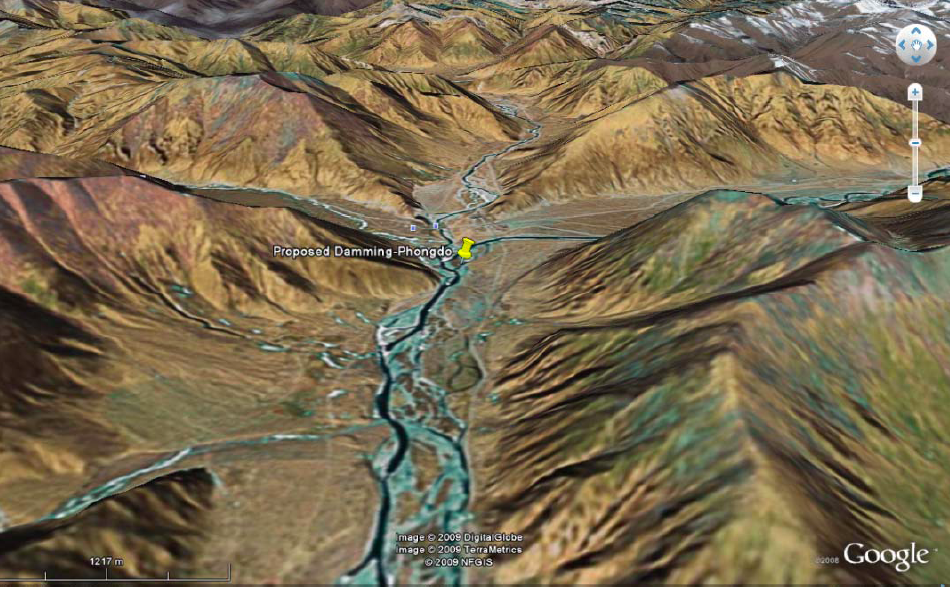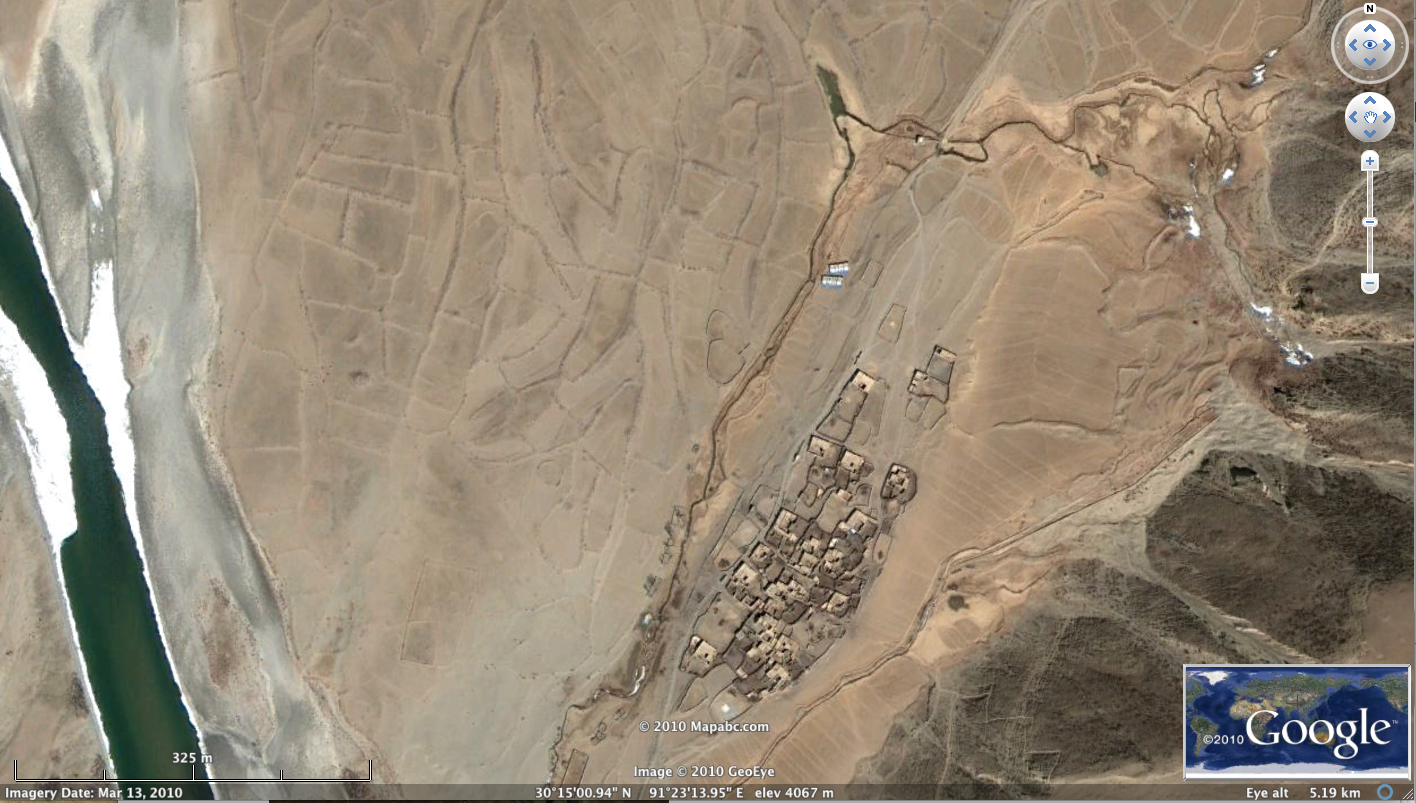- Joined
- Mar 8, 2011
- Messages
- 3,282
- Likes
- 316
Chinese engineers propose world's biggest hydro-electric project in Tibet
Mega-dam on Yarlung Tsangpo river would save 200m tonnes of CO2 but could spark conflict over downstream water supply
Jonathan Watts, Asia environment correspondent
guardian.co.uk, Monday 24 May 2010 16.00 BST

River on the roof of the world ... the Yarlung Tsangpo/Brahmaputra river. Photograph: Imaginechina
Chinese hydropower lobbyists are calling for construction of the world's biggest hydro-electric project on the upper reaches of the Brahmaputra river as part of a huge expansion of renewable power in the Himalayas.
Zhang Boting, the deputy general secretary of the China Society for Hydropower Engineering, told the Guardian that a massive dam on the great bend of the Yarlung Tsangpo - the Tibetan name for the river - would benefit the world, despite the likely concerns of downstream nations, India and Bangladesh, which access water and power from the river.
Zhang said research had been carried out on the project, but no plan has been drawn up. But documents on the website of a government agency suggest a 38 gigawatt hydropower plant is under consideration that would be more than half as big again as the Three Gorges dam, with a capacity nearly half as large as the UK's national grid.
"This dam could save 200m tonnes of carbon each year. We should not waste the opportunity of the biggest carbon emission reduction project. For the sake of the entire world, all the water resources than can be developed should be developed." That CO2 saving would be over a third of the UK's entire emissions.
The mega-facility is among more than 28 dams on the river that are either planned, completed or under discussion by China, according to Tashi Tsering, a Tibetan scholar of environmental policy at the University of British Columbia.
Tsering publishes a map today of all of the projects that have been reported by Chinese newspapers and hydro-engineering websites.
From this, he concludes that the Tsangpo-Brahmaputra – until recently considered the last great undammed river in Tibet – will be the next focus of government efforts to increase the nation's power supply. One of them is a map of planned dams showing a 38-gigawatt hydro-plant at Motuo on the website of Hydro China, an influential government enterprise responsible for dam construction. A separate State Grid map of future transmission lines indicates the remote area will soon be connected to the rest of China's power supply. Hydro China and State Grid declined requests for clarification.
The government has not confirmed the existence of the scheme, but Tsering cites several newspaper reports of survey teams exploring the area and provides links to other online documents that indicate preparations for large-scale hydro-development of the area.
Given the huge expense, technical difficulties and political sensitivities of the scheme, it is far from certain of final approval by the government. But several Chinese hydroengineers see it as the ultimate goal in an accelerating race with India to develop water resources in one of the planet's last remote regions.
Tapping the power of the river as it bends and plunges from the Himalayan roof of the world down towards the Indian and Bangladeshi flood plains has long been a dream of the world's hydro-engineers.
Along with the Congo river at the Inga falls, this is considered one of the two greatest concentrations of river energy on earth, but it was long thought impossible to access because of the rugged, high-altitude terrain and the risk of water-related conflict with neighbouring countries.
But China has overcome many engineering obstacles with the construction of the railway to Tibet, and its growing energy demands are spurring exploration of ever more remote areas.
"Tibet's resources will be converted into economic advantage," Yan Zhiyong, the general manager of China Hydropower Engineering Consulting Group, told China Energy News earlier this year. "The major technical constraints on damming the Yarlung Tsampo have been overcome." He declined the Guardian's request for an interview, saying the subject was too sensitive.
The exploitation of the Brahmaputra is already under way. China recently announced plans to build five dams further upstream, including a 500MW hydroplant at Zangmu, which is under construction by the power utility Huaneng.
According to Tsering, the biggest of them will be a huge plant at the great bend – either at Metog, known as Motuo in Chinese, or at Daduqia. The former would involve the construction of a series of tunnels, pipes, reservoirs and turbines to exploit the spectacular 2,000-metre fall of the river as it curls down towards India.
Although there has been no official confirmation of plans for a dam, the discussion is far from secret. On a prominent Chinese science forum, Zhang said a dam on the great bend was the ultimate hope for water resource exploitation because it could generate energy equivalent to 100m tonnes of crude coal, or all the oil and gas in the South China sea.
He warned that a delay would allow India to tap these resources and prompt "major conflict" in a region where the two nations have sporadically clashed over disputed territory.
"We should build a hydropower plant in Motuo ... as soon as possible because it is a great policy to protect our territory from Indian invasion and to increase China's capacity for carbon reduction," he wrote last year
Any step forward is likely to be controversial. Tibetans consider Metog a sacred region, and environmental activists warn against building such a huge project in a seismically active and ecologically fragile area.
"A large dam on the Tibetan plateau would amount to a major, irreversible experiment with geo-engineering," said Peter Bosshard of International Rivers. "Blocking the Yarlung Tsangpo could devastate the fragile ecosystem of the Tibetan plateau, and would withhold the river's sediments from the fertile floodplains of Assam in north-east India, and Bangladesh."
China's construction of dams also raises the prospect of a race with India to develop hydropower along south Asia's most important river.
"India needs to be more aggressive in pushing ahead hydro projects (on the Brahmaputra)," Jairam Ramesh, the Indian environment minister, told the Guardian during a recent visit to Beijing. "That would put us in better negotiating position (with China).
To minimise the risk of water-related conflict, the two nations have agreed to share information about hydro-plans on the Tsangpo-Brahmaputra.
Indian media have raised concerns that Beijing may ultimately embark on a gigantic diversion scheme that would channel water away from India to the dry northern plains of China, but such fears are dismissed by Tsering, who says the dam at Metog would be for hydropower, not water diversion. "The laws of physics will not allow water diversion from the Great Bend."
Chinese engineers propose world's biggest hydro-electric project in Tibet | Environment | The Guardian
Mega-dam on Yarlung Tsangpo river would save 200m tonnes of CO2 but could spark conflict over downstream water supply
Jonathan Watts, Asia environment correspondent
guardian.co.uk, Monday 24 May 2010 16.00 BST

River on the roof of the world ... the Yarlung Tsangpo/Brahmaputra river. Photograph: Imaginechina
Chinese hydropower lobbyists are calling for construction of the world's biggest hydro-electric project on the upper reaches of the Brahmaputra river as part of a huge expansion of renewable power in the Himalayas.
Zhang Boting, the deputy general secretary of the China Society for Hydropower Engineering, told the Guardian that a massive dam on the great bend of the Yarlung Tsangpo - the Tibetan name for the river - would benefit the world, despite the likely concerns of downstream nations, India and Bangladesh, which access water and power from the river.
Zhang said research had been carried out on the project, but no plan has been drawn up. But documents on the website of a government agency suggest a 38 gigawatt hydropower plant is under consideration that would be more than half as big again as the Three Gorges dam, with a capacity nearly half as large as the UK's national grid.
"This dam could save 200m tonnes of carbon each year. We should not waste the opportunity of the biggest carbon emission reduction project. For the sake of the entire world, all the water resources than can be developed should be developed." That CO2 saving would be over a third of the UK's entire emissions.
The mega-facility is among more than 28 dams on the river that are either planned, completed or under discussion by China, according to Tashi Tsering, a Tibetan scholar of environmental policy at the University of British Columbia.
Tsering publishes a map today of all of the projects that have been reported by Chinese newspapers and hydro-engineering websites.
From this, he concludes that the Tsangpo-Brahmaputra – until recently considered the last great undammed river in Tibet – will be the next focus of government efforts to increase the nation's power supply. One of them is a map of planned dams showing a 38-gigawatt hydro-plant at Motuo on the website of Hydro China, an influential government enterprise responsible for dam construction. A separate State Grid map of future transmission lines indicates the remote area will soon be connected to the rest of China's power supply. Hydro China and State Grid declined requests for clarification.
The government has not confirmed the existence of the scheme, but Tsering cites several newspaper reports of survey teams exploring the area and provides links to other online documents that indicate preparations for large-scale hydro-development of the area.
Given the huge expense, technical difficulties and political sensitivities of the scheme, it is far from certain of final approval by the government. But several Chinese hydroengineers see it as the ultimate goal in an accelerating race with India to develop water resources in one of the planet's last remote regions.
Tapping the power of the river as it bends and plunges from the Himalayan roof of the world down towards the Indian and Bangladeshi flood plains has long been a dream of the world's hydro-engineers.
Along with the Congo river at the Inga falls, this is considered one of the two greatest concentrations of river energy on earth, but it was long thought impossible to access because of the rugged, high-altitude terrain and the risk of water-related conflict with neighbouring countries.
But China has overcome many engineering obstacles with the construction of the railway to Tibet, and its growing energy demands are spurring exploration of ever more remote areas.
"Tibet's resources will be converted into economic advantage," Yan Zhiyong, the general manager of China Hydropower Engineering Consulting Group, told China Energy News earlier this year. "The major technical constraints on damming the Yarlung Tsampo have been overcome." He declined the Guardian's request for an interview, saying the subject was too sensitive.
The exploitation of the Brahmaputra is already under way. China recently announced plans to build five dams further upstream, including a 500MW hydroplant at Zangmu, which is under construction by the power utility Huaneng.
According to Tsering, the biggest of them will be a huge plant at the great bend – either at Metog, known as Motuo in Chinese, or at Daduqia. The former would involve the construction of a series of tunnels, pipes, reservoirs and turbines to exploit the spectacular 2,000-metre fall of the river as it curls down towards India.
Although there has been no official confirmation of plans for a dam, the discussion is far from secret. On a prominent Chinese science forum, Zhang said a dam on the great bend was the ultimate hope for water resource exploitation because it could generate energy equivalent to 100m tonnes of crude coal, or all the oil and gas in the South China sea.
He warned that a delay would allow India to tap these resources and prompt "major conflict" in a region where the two nations have sporadically clashed over disputed territory.
"We should build a hydropower plant in Motuo ... as soon as possible because it is a great policy to protect our territory from Indian invasion and to increase China's capacity for carbon reduction," he wrote last year
Any step forward is likely to be controversial. Tibetans consider Metog a sacred region, and environmental activists warn against building such a huge project in a seismically active and ecologically fragile area.
"A large dam on the Tibetan plateau would amount to a major, irreversible experiment with geo-engineering," said Peter Bosshard of International Rivers. "Blocking the Yarlung Tsangpo could devastate the fragile ecosystem of the Tibetan plateau, and would withhold the river's sediments from the fertile floodplains of Assam in north-east India, and Bangladesh."
China's construction of dams also raises the prospect of a race with India to develop hydropower along south Asia's most important river.
"India needs to be more aggressive in pushing ahead hydro projects (on the Brahmaputra)," Jairam Ramesh, the Indian environment minister, told the Guardian during a recent visit to Beijing. "That would put us in better negotiating position (with China).
To minimise the risk of water-related conflict, the two nations have agreed to share information about hydro-plans on the Tsangpo-Brahmaputra.
Indian media have raised concerns that Beijing may ultimately embark on a gigantic diversion scheme that would channel water away from India to the dry northern plains of China, but such fears are dismissed by Tsering, who says the dam at Metog would be for hydropower, not water diversion. "The laws of physics will not allow water diversion from the Great Bend."
Chinese engineers propose world's biggest hydro-electric project in Tibet | Environment | The Guardian






















